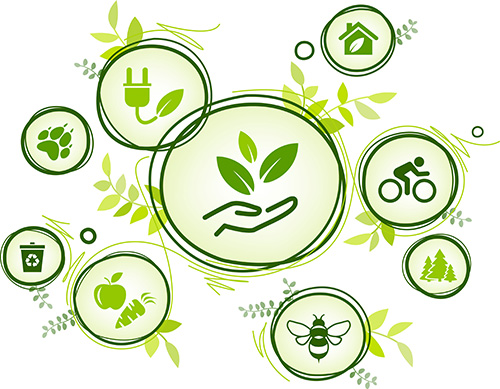Sustainable and healthy living
Scientific support: Prof. Dr. Baptist Gallwitz
A sustainable lifestyle with regular physical activity and a regional, seasonal plant-based diet is the best method to prevent type 2 diabetes – while also protecting the climate and environment.
The most effective measures for CO2 footprint reduction can be found in the Big Points for Sustainable Consumption released by the Competence Center for Sustainable Consumption. These include: “Plant-based diet” and “driving less”.

Contents
- What is meant by the term “sustainable lifestyle”?
- What does a sustainable lifestyle have to do with health and diabetes?
- Physical activity protects the climate and benefits health
- Diet: Healthy and sustainable
- What can I do for the climate, environment, and health?
- What does climate change mean for people with diabetes?
1. What is meant by the term “sustainable lifestyle”?
“Living in such a way that today, and in the future, all people can live like me” is the basic principle of a sustainable lifestyle. The central aims are slowing down climate change, maintaining resources, and observing the limits of what the earth can provide.
A good indicator of how sustainable your lifestyle is and the ecological effects on climate is the CO2 footprint. This refers to the amount of carbon dioxide produced due to the activities of one person. It is comprised of various factors.
In Germany, the average CO2 footprint is 10.8 tons per person per year. This is well above the global average of 6.5 tons! To achieve the 1.5-degree goal agreed by the international community in the Paris Climate Accords in 2015, it is necessary to reduce the CO2 footprint to less than 1 ton per capita. This would help keep the increase in global warming below 1.5-degrees by the year 2100 and limit the increase to below 2-degrees compared with preindustrial temperatures.
Video: Sustainable and healthy living – Tips and tricks
This video is available with English subtitles.
2. What does a sustainable lifestyle have to do with health and diabetes?
A lot. After all, a sustainable lifestyle is about protecting the earth so it remains livable and habitable for humans. This has a direct effect on health with global warming playing a significant role. These are the findings of the Lancet Countdown, an international collaborative project that independently assesses the health-related consequences of climate change. According to the panel of experts, climate change will be the decisive factor for human health.
Regarding a sustainable lifestyle, the following applies: The majority of our environmental and climate protection activities also benefit our health.
In the context of activity and diet, the expert recommendations for health and sustainability go hand in hand. A healthy lifestyle and regular physical activity coupled with a seasonal and regional diet is not only the best way to prevent insulin resistance, cardiovascular disease, and obesity – it also helps protect the climate and environment.
Good to know:
The information portal www.klima-mensch-gesundheit.de (Link in German) from the Federal Center for Health Education (BZgA in German) provides quality-assured and independent information on climate change, heat, and health.
3. Physical activity protects the climate and benefits health
For example, cycling or walking instead of driving helps reduce greenhouse gases, particulate matter, and nitrogen oxide gases, and make sure you get more exercise. This helps prevent cardiovascular disease, mental illness, and many other diseases as well as obesity – and as a consequence, the onset of type 2 diabetes. This is because exercise helps reduce blood sugar levels and increase the sensitivity of the body's cells to insulin. However, as the effect is short-lived, it is especially important to exercise regularly and integrate physical activity into everyday life.
Find out here more on how physical activity can help prevent the onset of type 2 diabetes.
Good to know:
The hormone insulin is needed in order for sugar (glucose) from the blood to enter the body’s cells. The cells of people with insulin resistance have less sensitivity to insulin causing a rise in blood sugar levels. Obesity, poor diet, and lack of physical activity all increase the risk of insulin resistance. This can result in the onset of type 2 diabetes.
People with type 1 diabetes can also develop insulin resistance if they have an unhealthy lifestyle. In this case – similar to type 2 diabetes – they require ever-increasing amounts of insulin to keep their blood sugar at normal levels. This is commonly referred to as “double diabetes”.
4. Diet: Healthy and sustainable
Malnutrition is prevalent in many regions of the world. Scientific calculations have shown that the current energy-intensive food production system used in the Western world is not only responsible for one-quarter of all greenhouse gas emissions, but is also detrimental to health. According to findings from the German Diabetes Society (DDG in German), this system leads to the over-consumption of processed high-calorie foods and animal products containing high levels of salt, sugar, and saturated fats. All these are factors in the onset of type 2 diabetes, obesity, cancer, and cardiovascular disease.
To solve this multitude of problems, the EAT Lancet Commission, an international network of scientists from the fields of nutrition, agriculture, and geoscience, developed the Planetary Health Diet. The German Diabetes Society (DDG) recommends using this nutritional concept as a guideline.
The concept envisages doubling the consumption of vegetables, pulses, fruit, and nuts and halving the consumption of meat and sugar. Moreover, it aims to improve food production methods and reduce food waste.
An example of the implementation of the Planetary Health Diet is as follows:
- 1 to 2 eggs per week,
- one piece of meat and fish and
- no more than 250 g of dairy product per day.
- The remainder should consist of vegetables, fruit, and cereals.
Furthermore, when shopping, pay attention to the origin of the food purchased. Fresh, unpackaged, local produce that has not been transported a long distance or grown in a heated greenhouse is particularly sustainable.
Find out more about what a healthy, balanced, mixed diet looks like here.
Did you know?
The CO2 footprint of meals can differ greatly when you replace certain ingredients. For example:
- Beef meatballs with rice and fresh peas: 2.0 kilograms of CO2e*
- Soy-based veggie burger with rice and fresh peas: 1.0 kilograms of CO2e*
Find the CO2 footprints of more foods and meals here (Link in German).
*CO2e: The abbreviation CO2e stands for CO2-equivalent. This means that, alongside CO2, the effects of other greenhouse gases were included in the calculation.
5. What can I do for the climate, environment, and health?
It is important to reduce your own CO2 footprint. There are many ways to achieve this in everyday life. But which are the most effective?
Indications are provided by the Big Points released by the Competence Center for Sustainable Consumption. It identified 7 measures that can reduce the average annual CO2 footprint per person of 10.8 tons by half. These measures are:
- Water-saving showerhead
A water-saving showerhead reduces water usage when showering by almost half, therefore saving on the energy used to heat the water. Installation takes around 10 minutes and savings are made with every shower. The water-saving showerhead not only reduces your own footprint but also that of the other members of the household.
- Avoiding flying
A return flight from Frankfurt to Barcelona generates almost half a ton of CO2. This means that even a short weekend trip can significantly enlarge even the smallest of carbon footprints. Therefore, flying should be looked at very closely when trying to half your carbon footprint. Avoiding flying is a Big Point.
- Insulated living spaces
Good house insulation reduces energy consumption for heating and rapidly saves half a ton or more of CO2 annually per person. It is most effective to insulate the building envelope; however, smaller measures can also help save energy.
- Plant-based diet
A vegetarian or vegan diet avoids the production of up to half a ton of greenhouse gases. Those who follow a (environmentally-) conscious diet often choose to buy seasonal, regional, and organic foods, which are all lower in CO2.
- Green electricity
Switching to green electricity is easy and saves on average more than half a ton of CO2 per person. Make sure to look for labeled green electricity when selecting a tariff. The “Grüner-Strom” (Green Electricity) label and the Ok Power label guarantee that the use of green electricity will promote new power plants (Websites in German).
- Drive less
Those who do not use a car on a daily basis are implementing a Big Point. This is because frequently traveling short distances by car adds up over the course of the year, e.g., driving to work or dropping the children off at kindergarten. Less frequent journeys, such as going on vacation, taking trips, or transporting things, play a less significant role. Carsharing provides an alternative to owning a car, because if you don’t own a car, you won’t be tempted to use it more than you should.
- Conscious consumption
The lower the level of consumption, the smaller the footprint. There are many ways to consume less. Extending the useful life of a product by repairing, buying second-hand, and borrowing – i.e., buy fewer new things and use what is already on hand. Saving and investing money also stops you from spending on consumer goods. Private assets held in green investments or checking accounts make an important contribution to climate protection. Combined, these actions result in the Big Point of “conscious consumption”.
Good to know:
How big is your CO2 footprint? Here you can visit the German Environment Agency CO₂-calculator (Link in German).
6. What does climate change mean for people with diabetes?
Addressing climate change and knowing, for example, how the body reacts to permanently high temperatures, is especially important for people with diabetes. This is because the expected increase in periods of high temperatures is more problematic for those with diabetes than for people with a healthy metabolism. This is especially true for older people with diabetes. Find out more about the reduced heat tolerance of people with diabetes here.
Sources:
Aachener Stiftung Kathy Beys: Lexikon der Nachhaltigkeit. (Letzter Abruf: 26.04.2022)
Bundeszentrum für Ernährung: Mein Essen – unser Klima. Einfache Tipps zum Klimaschutz. 4. Auflage. 2019
Bundeszentrum für Ernährung: Planetary Health Diet. Speiseplan für eine gesunde und nachhaltige Ernährung. (Letzter Abruf: 26.04.2022)
Bundesministerium für Bildung und Forschung: Was ist BNE? (Letzter Abruf: 26.04.2022)
Bundesministerium für wirtschaftliche Zusammenarbeit und Entwicklung: Nachhaltigkeit (nachhaltige Entwicklung). (Letzter Abruf: 26.04.2022)
Bundeszentrale für gesundheitliche Aufklärung: Nationale Empfehlungen für Bewegung und Bewegungsförderung. Sonderheft 03. 2016
Bundeszentrale für gesundheitliche Aufklärung: Neue Broschüre „Menschen in Bewegung bringen“. Nationale Empfehlungen für Bewegung und Bewegungsförderung in Kurzform. (Letzter Abruf: 26.04.2022)
Bundeszentrum für Ernährung: Ernährung und Klimaschutz. (Letzter Abruf: 26.04.2022)
Climate Watch: Historical GHG Emissions. (Letzter Abruf: 26.04.2022)
Deutsche Diabetes Gesellschaft: „Diabetes-Prävention und Klimaschutz sind zwei Seiten einer Medaille“. (Letzter Abruf: 26.04.2022)
Die Bundesregierung: Deutsche Nachhaltigkeitsstrategie. Weiterentwicklung 2021
Kompetenzzentrum Nachhaltiger Konsum: Mit Big Points den Fußabdruck halbieren. (Letzter Abruf: 26.04.2022)
Reinhardt, G. et al.: Ökologische Fußabdrücke von Lebensmitteln und Gerichten in Deutschland. Heidelberg. 2020
Romanello, M. et al.: Der Lancet Countdown Jahresbericht 2021 zu Gesundheit und Klimawandel: Alarmstufe Rot für eine gesunde Zukunft. 2021
The EAT-Lancet Commission on Food, Planet, Health: The Planetary Health Diet. (Letzter Abruf: 26.04.2022)
The Lancet Countdown on Health and Climate Change: Policy Brief für Deutschland 2020. 2020
Watts, N. et al.: The 2020 report of The Lancet Countdown on health and climate change: responding to converging crises. In: Lancet, 2020, 9: 129-170
Zilbermint, M.: Diabetes and climate change. In: J Community Hosp Intern Med Perspect, 2020, 10: 409-412
As of: 08.08.2022





